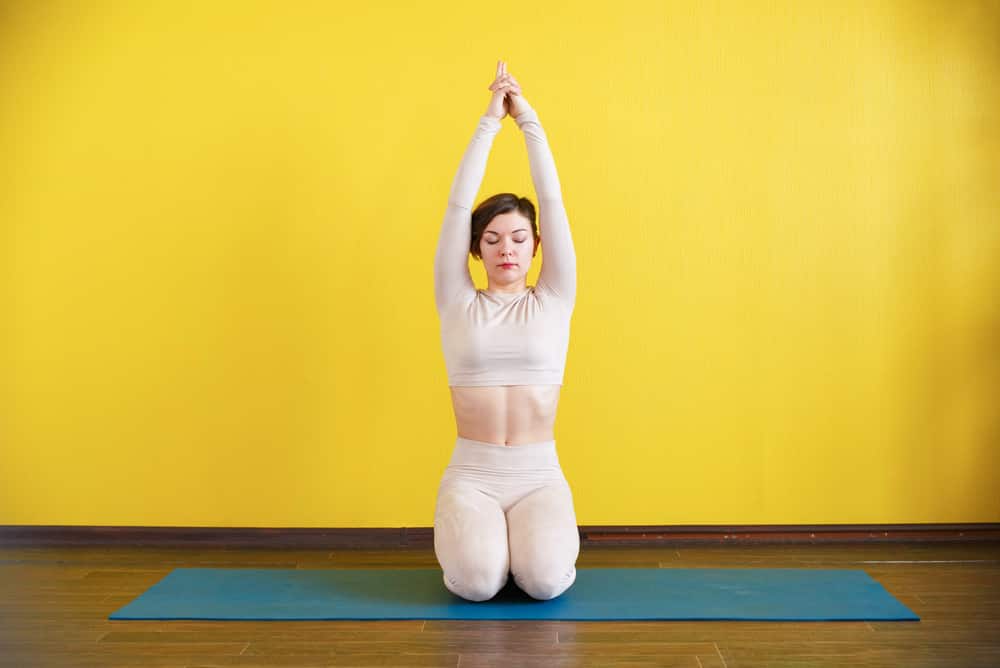Kundalini yoga meditation is an ancient practice from the east that has been slowly gaining popularity among the western countries and some big name celebrities. Those who practice kundalini yoga meditation claim that it helps them build strength, improves brain health, promotes mindfulness, and a heightened state of consciousness.
Despite its rave reviews, one might wonder if this practice truly works as advertised or if it is another craze – popularized by ill-informed media personalities – that is bound to fade away in a few months. If you are curious to know what it is, what are the benefits of kundalini yoga meditation, or just wish to learn how to do kundalini yoga meditation, read on to learn all the facts.
What Is Kundalini Yoga Meditation?
This practice is a combination of kundalini yoga and kundalini meditation. While these two practices could be done separately, they are more often than not combined and done at the same time, whether consciously or unconsciously. In light of this, kundalini yoga meditation can be referred to as a combination of breath, movement, and sound.
What is the main purpose of kundalini yoga meditation? While this activity has multiple benefits that attract people to it, the main motivation behind it is to awaken the kundalini energy that is found in all of us. What is kundalini energy? In Sanskrit – the classical South Asian language and the holy language of Hinduism, – the word “Kundalini” means “coiled snake”.
Based on an ancient belief – approximately 1,000 BCE to 500 BCE – everyone has a divine energy that rests at the base of their spine, at the sacrum. This belief further states that through this specific form of meditation one can “uncoil the snake” thus awakening, releasing, and harnessing the kundalini energy – divine energy – that is within them. This energy is said to move up from the base of your spine, through the seven chakras and out through the 7th chakra found at the very top of your head -crown chakra.
Read More: Yoga Before or After Workout: When is Zenning Out More Beneficial?
What Is The Difference Between Kundalini Yoga And Meditation
Kundalini yoga is described as a combination of meditation, breathing exercises, mantras, and physical yoga poses. On the other hand, meditation is defined as a continuous practice that helps you to train your mind, create a heightened state of awareness, and focus your thoughts. While there are different kinds of meditation, some that require mantras just like kundalini yoga, the main difference in these two popular practices is that meditation does not require any physical yoga poses.
Running a never-ending rat race, shoving trauma further and further away, falling into self-harming thought patterns, living life that’s eclipsed by constant anxiety and fear – this is what an average person goes through every day. Nor addressing it will only pull you deeper into a downward spiral. BetterMe: Meditation & Sleep app will help you gain a new perspective on life and help you regain that long-lost internal balance!
The Basics Of Kundalini Yoga Meditation
As we have stated above, kundalini yoga meditation is a combination of breath, movement and sound. Breath in this case refers to the kundalini breathing exercises that are used in this practice. They include:
Alternate Nostril Breathing
- Sit in a comfortable position, raise one hand to the front of your face and close your eyes.
- With your right thumb, press and close your right nostril.
- Inhale slowly and deeply through your left nostril and pause.
- Using your right-hand pinky, close the left nostril and release the right thumb from the right nostril.
- Exhale fully through the right nostril and repeat the whole process again.
- Continue this exercise for 30 minutes.
Breath Of Fire
- Sit in a comfortable position and take several deep long breaths.
- After your last inhalation, exhale from your nose and force all of the air from your lungs by contracting your core muscles – abdominal muscles.
- Immediately inhale through your nose, allowing the air to flow back into your lungs.
- Quickly push out all the air from your lungs by contracting your core muscles and then release and inhale to let the air back in.
Please note that the breath of fire is done in rapid, powerful movements – about 2 to 3 breaths per second.
Long Deep Breathing
- While seated in a comfortable position, rest the tip of your tongue on the roof of your mouth, and inhale as slowly as possible through your nose, keeping your mouth open.
- Focus on first filling your stomach with air, then your diaphragm, finally your chest.
- Pause for a moment and then exhale slowly through your nose. Start with releasing the air in your chest, followed by the diaphragm and finally from your abdomen.
Soham Mantra Breathing
- While seated in a comfortable position, exhale deeply through your nose keeping your focus on your diaphragm as you make the sound “hum”.
- Inhale deeply, expanding your ribcage as you focus on the word “so.”
- Repeat this several times.
Kundalini Yoga Meditation Mantras
In meditation, mantras are used to boost awareness and improve concentration. They are said to help keep you focused and that using them may lead to improved results in meditation. In Kundalini yoga, mantras are part and parcel of the practice. While there are too many Kundalini yoga meditation mantras to count, here are some common ones that you may or have already encountered:
1. Ong Namo Guru Dev Namo – it means ‘I honor (or bow to) the Infinite Wisdom, I honor the teacher within.’
2. Ardas Bhaee Amar Das Guru, Amar Das Guru, Ardas Bhaee, Ram Das Guru, Ram Das Guru, Ram Das Guru, Sachee Sahee.
3.Aad Guray Nameh, Jugaad Guray Nameh, Sat Guray Nameh, Siri Guru Dav-vay Nameh – a mantra to seek guidance and protection.
4. Ek Ong Kar – it means that ‘the creator and creation are one.’
5. Sa Ta Na Ma – it means ‘birth, life, death, rebirth’ and some believe that with habitual practice, it could boost your memory.
6. Har – it means God, Divine, or Creative Infinity and is used to attract abundance in your life.
7. Sat Nam – it means either I am truth, Truth is my identity or Truth is my essence.
Kundalini Yoga Mudras
A mudra means either seal, gesture, or mark and is a symbolic gesture used in yoga and practiced using your hands and fingers. It is believed that each area of the hand corresponds to a certain area of the body and to different emotions and behaviors. In light of this, each mudra technique sends clear messages to your body and mind. Some examples of mudras that you could use during your kundalini yoga meditation include:
-
Seal Of Knowledge – Aka Gyan Mudra
Touch the tip of the index finger to the tip of the thumb. Keep the other three fingers straight. This gesture is said to stimulate knowledge, wisdom, receptivity, and calmness.
-
Seal Of Mental Clarity – Aka Buddhi Mudra
It is done by touching the tip of the little (pixie) finger to the tip of the thumb while keeping the other fingers straight. It is said to help us communicate clearly and intuitively, and stimulate psychic development.
-
Seal Of Patience – Aka Shuni Mudra
Touch the tip of the middle finger to the tip of the thumb while keeping the other 3 fingers straight. This seal promotes patience, discernment, and commitment.
Read More: Meditation Hand Positions: Why You Should Add Mudras To Your Meditation
-
Seal Of Sun, Life – Aka Surya Or Ravi Mudra
Touch the tip of your ring finger to the tip of thumb and be sure to keep the other fingers straight. This promotes good health, nerve strength and revitalizes your energy.
-
Prayer Pose – Aka Pranam Mudra
A bit like yin and yang, this pose is said to neutralize the positive side of the body (right, sun, masculine) with the negative side (left, moon, feminine).
-
Venus Lock
This gesture improves concentration, channels sexual energy, and promotes glandular balance.
Kundalini Yoga Meditation Poses
When it comes to poses, different postures are used for different reasons you can use some poses to help you break bad habits, to awaken the 10 bodies, or to detoxify your body and promote mental clarity.
How To Do Kundalini Yoga Meditation For Beginners?
Kundalini yoga mediation can be quite intimidating, especially for beginners. To avoid doing too much and getting overwhelmed, here are some simple steps to follow:
1. Pick A Quiet, Peaceful Location
This helps you concentrate better than if you chose to do this practice in a loud area.
2. Choose The Right Clothes
Those who practice this form of meditation are encouraged to wear modest, graceful, and comfortable clothes that allow freedom of movement. They also almost always wear white because the colour expands your aura. White is also believed to boost mindfulness because keeping white clothes pristine takes more effort and care.
3. Pick A Time
While you can practice kundalini yoga meditation at any time, it is advisable to do so in the morning as it helps you set your intentions for the day. Set a timer so you do not lose track of time.
4. Find A Comfortable Position
You could either sit on the ground or choose to sit on a chair with your feet on the floor. Whichever position you choose, make sure you are as comfortable as can be to avoid fidgeting.
5. Choose A Time Limit
While it might be tempting to dive in and try meditating for 30 minutes, slow down and start small. Practitioners of this claim that a 3-minute meditation affects blood circulation and the electromagnetic field of the body; an 11-minute meditation stimulates and balances the glandular and nervous systems; and a 31-minute deep meditation affects all your cells and clears the subconscious.
6. Choose A Mantra
Any of the above mentioned mantras are a good option as they help you concentrate. You can repeat the mantra under your breath or loudly.
7. Incorporate Mudras
Depending on what goal you are after, choose a mudra that works for you.
8. Focus On Your Breathing
Alternate nostril breathing is the best kundalini yoga meditation technique for beginners.
Once your timer rings, inhale deeply, raise your arms, exhale, relax and open your eyes.
What Are The Benefits Of Kundalini Yoga Meditation?
The benefits of this practice are many and varied. Those who have spent years following this exercise claim that kundalini yoga meditation has helped them:
- Have a clear mind and given them bursts of inspiration.
- Increased mindfulness and compassion.
- Improved their communication with others.
- Helped them find their purpose and set their intentions.
- Develop sharper intuition. Just as with meditation, using kundalini yoga meditation for intuition could help sharpen it.
BetterMe: Meditation & Sleep app can help you transmute stress into serenity, pull you up from the doldrums, free your mind from the cares and worries of the world, quell racing thoughts and infuse you with tranquility! Start using it now and change your life!
What Does Science Say About The Benefits Of Kundalini Yoga?
-
Improves Your Mood
A study done in 1986 showed that regularly engaging in this practice could work as a non-medical measure in treating patients with mental depression as it produces serotonin (4).
-
Kundalini Yoga Meditation For Sleep
Practicing Shabad Kriya every night before bed is one of the best ways to help you fall asleep using this practice. Here is how to do it:
- Sit or lie down with the spine straight. Place the hands in your lap, with the palms up – the right hand over the left.
- The thumbs are together and point forward.
- Inhale in 4 equal parts, mentally repeating the mantra Sa-Ta-Na-Ma.
- Hold your breath, repeating the mantra 4 times for a total of 16 beats.
- Exhale in 2 equal strokes and repeat the process all over again.
Continue this for 15 to 62 minutes and you will start sleeping better.
-
Kundalini Yoga Meditation For Anxiety
In 2018, a study of the efficacy of this practice on generalized anxiety disorder (GAD) revealed that this exercise may be used as a way to reduce the symptoms of GAD (2).
-
Lowers Blood Pressure
A study published in 2018 revealed that even the simplest form of kundalini yoga can help reduce blood pressure in middle aged (30 to 45 years old) hypertensive women (1).
-
Kundalini Yoga Meditation For Self-Love
If you have been harming yourself through harsh words or other means, then the Kundalini yoga meditation for self love could help you be better towards yourself. The particular kriya/action for this is called the ‘Reverse Adi Shakti Kriya’ and is said to open the heart, create a positive relationship to the self, and make you available to receive love. Done for about 17 minutes and in 3 steps you practice self love by mentally and hypnotically blessing yourself.
-
Kundalini Yoga Meditation To Release Stress
With stress leading to the most common mental disorders today, finding a kundalini yoga meditation pose to help release it can be quite beneficial. One such example is as follows:
- Sit cross-legged and keep your neck locked.
- Relax your arms, bend them at the elbow and bring them to your body, lifting them about an inch above the navel.
- Rest the right hand in the palm of the left hand and place the thumb tips together pulling them towards your body.
- Inhale deeply and exhale completely as you chant the mantra Sat Naam Sat Naam Sat Naam Sat Naam Sat Naam Sat Naam Wha-Hay Guroo.
- Do this for about 11 minutes before finally inhaling deeply, holding your breath, stretching your arms above your head and slowly relaxing.
A study done in 2018 showed that this practice may offer immediate stress relief (3).
DISCLAIMER:
This article is intended for general informational purposes only and does not address individual circumstances. It is not a substitute for professional advice or help and should not be relied on to make decisions of any kind. A licensed physician should be consulted for diagnosis and treatment of any medical conditions. Any action you take upon the information presented in this article is strictly at your own risk and responsibility!
SOURCES:
- EFFECT OF YOGIC PRACTICES ON SYSTOLIC AND DIASTOLIC BLOOD PRESSURE AMONG HYPERTENSIVE MIDDLE AGED WOMEN (2017, researchgate.net)
- Kundalini Yoga for Generalized Anxiety Disorder: An Exploration of Treatment Efficacy and Possible Mechanisms (2018, pubmed.ncbi.nlm.nih.gov)
- Longitudinal and Immediate Effect of Kundalini Yoga on Salivary Levels of Cortisol and Activity of Alpha-Amylase and Its Effect on Perceived Stress (2017, ncbi.nlm.nih.gov)
- Mental depression and kundalini yoga (1986, pubmed.ncbi.nlm.nih.gov)



















